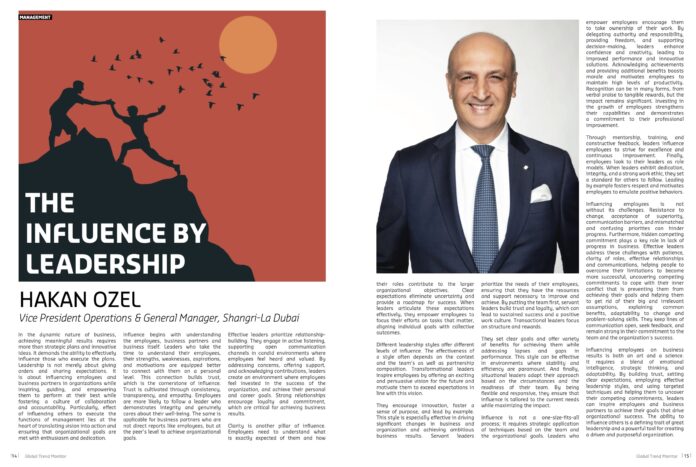HAKAN OZEL, Vice President Operations & General Manager, Shangri-La Dubai
In the dynamic nature of business, achieving meaningful results requires more than strategic plans and innovative ideas. It demands the ability to effectively influence those who execute the plans. Leadership is not merely about giving orders and sharing expectations. It is about influencing employees and business partners in organizations while inspiring, guiding, and empowering them to perform at their best while fostering a culture of collaboration and accountability. Particularly, effect of influencing others to execute the functions of management lies at the heart of translating vision into action and ensuring that organizational goals are met with enthusiasm and dedication.
Influence begins with understanding the employees, business partners and business itself. Leaders who take the time to understand their employees, their strengths, weaknesses, aspirations, and motivations are equipped better to connect with them on a personal level. This connection builds trust, which is the cornerstone of influence. Trust is cultivated through consistency, transparency, and empathy. Employees are more likely to follow a leader who demonstrates integrity and genuinely cares about their well-being. The same is applicable for business partners who are not direct reports like employees, but at the peer’s level to achieve organizational goals.
Effective leaders prioritize relationship-building. They engage in active listening, supporting open communication channels in candid environments where employees feel heard and valued. By addressing concerns, offering support, and acknowledging contributions, leaders create an environment where employees feel invested in the success of the organization, and achieve their personal and career goals. Strong relationships encourage loyalty and commitment, which are critical for achieving business results.
Clarity is another pillar of influence. Employees need to understand what is exactly expected of them and how their roles contribute to the larger organizational objectives. Clear expectations eliminate uncertainty and provide a roadmap for success. When leaders articulate these expectations effectively, they empower employees to focus their efforts on tasks that matter, aligning individual goals with collective outcomes.
Different leadership styles offer different levels of influence. The effectiveness of a style often depends on the context and the team’s as well as partnership composition. Transformational leaders inspire employees by offering an exciting and persuasive vision for the future and motivate them to exceed expectations in line with this vision. They encourage innovation, foster a sense of purpose, and lead by example. This style is especially effective in driving significant changes in business and organization and achieving ambitious business results. Servant leaders prioritize the needs of their employees, ensuring that they have the resources and support necessary to improve and achieve. By putting the team first, servant leaders build trust and loyalty, which can lead to sustained success and a positive work culture. Transactional leaders focus on structure and rewards. They set clear goals and offer variety of benefits for achieving them while addressing lapses and gaps in performance. This style can be effective in environments where stability and efficiency are paramount. And finally, situational leaders adapt their approach based on the circumstances and the readiness of their team. By being flexible and responsive, they ensure that influence is tailored to the current needs while maximizing the impact.
Influence is not a one-size-fits-all process; it requires strategic application of techniques based on the team and the organizational goals. Leaders who empower employees encourage them to take ownership of their work. By delegating authority and responsibility, providing freedom, and supporting decision-making, leaders enhance confidence and creativity, leading to improved performance and innovative solutions. Acknowledging achievements and providing additional benefits boosts morale and motivates employees to maintain high levels of productivity. Recognition can be in many forms, from verbal praise to tangible rewards, but the impact remains significant. Investing in the growth of employees strengthens their capabilities and demonstrates a commitment to their professional improvement. Through mentorship, training, and constructive feedback, leaders influence employees to strive for excellence and continuous improvement. Finally, employees look to their leaders as role models. When leaders exhibit dedication, integrity, and a strong work ethic, they set a standard for others to follow. Leading by example fosters respect and motivates employees to emulate positive behaviors.
Influencing employees is not without its challenges. Resistance to change, acceptance of superiority, communication barriers, and mismatched and confusing priorities can hinder progress. Furthermore, hidden competing commitment plays a key role in lack of progress in business. Effective leaders address these challenges with patience, clarity of roles, effective relationships and communications, helping people to overcome their limitations to become more successful, uncovering competing commitments to cope with their inner conflict that is preventing them from achieving their goals and helping them to get rid of their big and irrelevant assumptions, explaining common benefits, adaptability to change and problem-solving skills. They keep lines of communication open, seek feedback, and remain strong in their commitment to the team and the organization’s success.
Influencing employees on business results is both an art and a science. It requires a blend of emotional intelligence, strategic thinking, and adaptability. By building trust, setting clear expectations, employing effective leadership styles, and using targeted techniques and helping them to uncover their competing commitments, leaders can inspire employees and business partners to achieve their goals that drive organizational success. The ability to influence others is a defining trait of great leadership and a powerful tool for creating a driven and purposeful organization.
#GTM #GlobalTrendMonitor #Magazine #HakanOzel #LeadershipMatters #LeadWithInfluence #InspiringLeadership #TransformationalLeadership #LeadershipDevelopment #BusinessSuccess #EmpoweredTeams #TrustAndLeadership #EffectiveLeadership #OrganizationalGrowth
